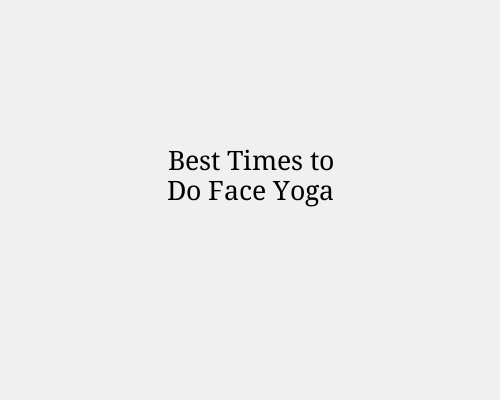
Best Times to Do Face Yoga for Maximum Anti-Aging Benefits
Face yoga has gained popularity as a natural, non-invasive method to tone facial muscles, improve circulation, and reduce the appearance of wrinkles. Like any fitness routine, the timing of your face yoga practice can significantly impact its effectiveness. For those seeking to use face yoga for anti-aging purposes, it’s essential to understand not just how to do it, but also when.
This article explores the best times of day to perform face yoga for maximum anti-aging results, supported by both practical considerations and biological rhythms.
Morning: Jumpstart Circulation and Reduce Puffiness
Why it works:
Performing face yoga in the morning helps stimulate blood flow to the facial muscles, which can reduce puffiness and give your face a fresher, more lifted look for the day ahead. Morning sessions activate facial muscles that may have relaxed during sleep, increasing oxygen supply to skin tissues and helping reduce fluid retention.
Best exercises for the morning:
The V: Reduces puffiness around the eyes.
Cheek Lifter: Energizes your facial expression.
Neck Tightener: Targets sagging jawlines and double chins.
Bonus tip: Combine face yoga with a splash of cold water or a jade roller to tighten the skin further and stimulate lymphatic drainage.
Midday: Reset Facial Tension and Prevent Wrinkle Formation
Why it works:
During the day, stress and screen time can lead to unconscious facial tension—especially in the forehead, eyes, and jaw. This habitual tension accelerates wrinkle development. A midday face
yoga session can serve as a natural "reset" by relaxing overused muscles and re-engaging underused ones.
Best exercises for midday:
Forehead Smoother: Reduces frown lines and tension from screen use.
Jaw Release: Alleviates tightness from clenching or grinding.
Eye Firmer: Relieves eye strain from prolonged screen exposure.
When to do it:
Schedule this during a lunch break or between meetings. A short 5–10-minute session is enough to refresh your face and prevent premature aging due to habitual expressions.
Evening: Promote Relaxation and Skin Regeneration
Why it works:
Evening face yoga helps relax facial muscles, making it easier for your skin to regenerate during sleep. Nighttime is when your body enters repair mode, and a relaxed, tension-free face is more likely to benefit from increased collagen production and cellular renewal.
Best exercises for the evening:
Face Stretching: Releases all facial tension built up during the day.
Neck and Shoulder Rolls: Promote better blood flow and posture correction.
Deep Breathing with Facial Massage: Calms the nervous system and prepares you for restful sleep.
Bonus tip: Combine your session with your nightly skincare routine. Doing face yoga after applying moisturizer or facial oil enhances absorption and improves skin elasticity.
Weekly Face Yoga Routine for Optimal Results
To see consistent anti-aging results, it’s crucial to make face yoga a habit. Here’s a suggested weekly routine:
Monday–Friday:
Morning (5–10 minutes): Light toning and circulation-boosting exercises.
Midday (5 minutes): Quick tension-release routine.
Evening (10–15 minutes): Deep relaxation and full-face stretching.
Saturday–Sunday:
One longer session (20–30 minutes): Focus on problem areas like jowls, crow’s feet, or frown lines.
Use tools like gua sha or facial rollers for added benefit.
Consistency over time is what delivers visible results. Like any form of exercise, face yoga doesn’t produce overnight miracles—but regular practice can noticeably lift, firm, and rejuvenate your skin.
Timing Tips to Maximize Anti-Aging Benefits
Be consistent: Practicing daily at roughly the same times trains your facial muscles more effectively.
Avoid doing face yoga immediately after a heavy meal: Digestion can reduce blood flow to the skin.
Hydrate before and after: Proper hydration supports collagen production and muscle elasticity.
Combine with sun protection and skincare: No anti-aging routine is complete without SPF and hydration.
What to Expect Over Time
Week 1–2: Improved circulation and a fresher appearance in the morning.
Week 3–4: Reduced puffiness and some visible muscle tone.
1–3 months: Smoother expression lines, better facial symmetry, and firmer skin.
6 months+: Significant lifting effects, fewer fine lines, and a more youthful contour— especially around the jawline, eyes, and forehead.
Final Thoughts
Timing your face yoga sessions around your natural daily rhythm enhances its anti-aging effects. A short morning boost, a midday reset, and a relaxing evening stretch create the perfect balance to fight wrinkles, sagging, and dullness. Just like any wellness practice, consistency is key. You don’t need expensive tools or invasive treatments—just your hands, your breath, and a few minutes a day.
Face yoga won’t replace a full anti-aging regimen, but when done regularly at optimal times, it becomes a powerful tool to naturally tone, lift, and rejuvenate your skin.